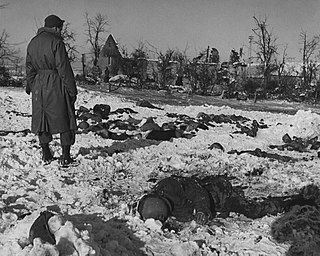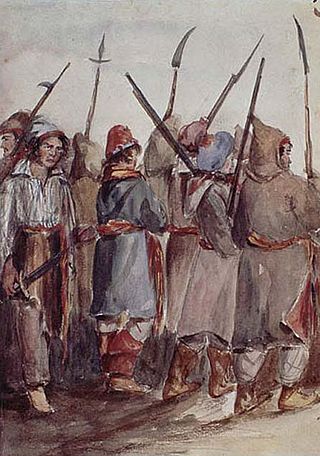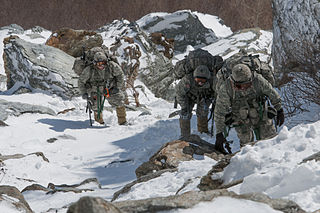
Guerrilla warfare is a form of unconventional warfare in which small groups of irregular military, such as rebels, partisans, paramilitary personnel or armed civilians including recruited children, use ambushes, sabotage, terrorism, raids, petty warfare or hit-and-run tactics in a rebellion, in a violent conflict, in a war or in a civil war to fight against regular military, police or rival insurgent forces.

Asymmetric warfare is a type of war between belligerents whose relative military power, strategy, or tactics differ significantly. This type of warfare often, but not necessarily, involves insurgents or resistance movement militias who may have the status of unlawful combatants against a standing army.

A war crime is a violation of the laws of war that gives rise to individual criminal responsibility for actions by combatants in action, such as intentionally killing civilians or intentionally killing prisoners of war, torture, taking hostages, unnecessarily destroying civilian property, deception by perfidy, wartime sexual violence, pillaging, and for any individual that is part of the command structure who orders any attempt to committing mass killings including genocide or ethnic cleansing, the granting of no quarter despite surrender, the conscription of children in the military and flouting the legal distinctions of proportionality and military necessity.
A resistance movement is an organized group of people that tries to resist the government or an occupying power, causing disruption and unrest in civil order and stability. Such a movement may seek to achieve its goals through either the use of violent or nonviolent resistance, or the use of force, whether armed or unarmed. In many cases, as for example in the United States during the American Revolution, or in Norway in the Second World War, a resistance movement may employ both violent and non-violent methods, usually operating under different organizations and acting in different phases or geographical areas within a country.
Military strategy is a set of ideas implemented by military organizations to pursue desired strategic goals. Derived from the Greek word strategos, the term strategy, when first used during the 18th century, was seen in its narrow sense as the "art of the general", or "the art of arrangement" of troops. and deals with the planning and conduct of campaigns, the movement and disposition of forces, and the deception of the enemy.

The Malayan Emergency, also known as the Anti–British National Liberation War(1948–1960), was a guerrilla war fought in British Malaya between communist pro-independence fighters of the Malayan National Liberation Army (MNLA) and the military forces of the Federation of Malaya, British Empire and Commonwealth. The communists fought to win independence for Malaya from the British Empire and to establish a socialist economy, while the Malayan Federation and Commonwealth forces fought to combat communism and protect British economic and colonial interests. The term "Emergency" was used by the British to characterise the conflict in order to avoid referring to it as a war, because London-based insurers would not pay out in instances of civil wars.
People's war or protracted people's war is a Maoist military strategy. First developed by the Chinese communist revolutionary leader Mao Zedong (1893–1976), the basic concept behind people's war is to maintain the support of the population and draw the enemy deep into the countryside where the population will bleed them dry through guerrilla warfare and eventually build up to mobile warfare. It was used by the Chinese communists against the Imperial Japanese Army in World War II, and by the Chinese Soviet Republic in the Chinese Civil War.

A low-intensity conflict (LIC) is a military conflict, usually localised, between two or more state or non-state groups which is below the intensity of conventional war. It involves the state's use of military forces applied selectively and with restraint to enforce compliance with its policies or objectives.
Attrition warfare is a military strategy consisting of belligerent attempts to win a war by wearing down the enemy to the point of collapse through continuous losses in personnel, materiel, and morale. The word attrition comes from the Latin root atterere, meaning "to rub against", similar to the "grinding down" of the opponent's forces in attrition warfare.

An insurgency is a violent, armed rebellion by small, lightly armed bands who practice guerrilla warfare against a larger authority. The key descriptive feature of insurgency is its asymmetric nature: small irregular forces face a large, well-equipped, regular military force state adversary. Due to this asymmetry, insurgents avoid large-scale direct battles, opting instead to blend in with the civilian population where they gradually expand territorial control and military forces. Insurgency frequently hinges on control of and collaboration with local populations.

Jungle warfare or woodland warfare is warfare in forests, jungles, or similar environments. The term encompasses military operations affected by the terrain, climate, vegetation, and wildlife of densely-wooded areas, as well as the strategies and tactics used by military forces in these situations and environments.

In civil and military jurisprudence, summary execution is the putting to death of a person accused of a crime without the benefit of a free and fair trial. The term results from the legal concept of summary justice to punish a summary offense, as in the case of a drumhead court-martial, but the term usually denotes the summary execution of a sentence of death. Under international law, it is a combatant's refusal to accept an opponent's lawful surrender and the combatant's provision of no quarter, by killing the surrendering opponents.
Fourth-generation warfare (4GW) is conflict characterized by a blurring of the distinction between war and politics, and of the distinction between combatants and civilians.

Irregular military is any non-standard military component that is distinct from a country's national armed forces. Being defined by exclusion, there is significant variance in what comes under the term. It can refer to the type of military organization, or to the type of tactics used. An irregular military organization is one which is not part of the regular army organization. Without standard military unit organization, various more general names are often used; such organizations may be called a troop, group, unit, column, band, or force. Irregulars are soldiers or warriors that are members of these organizations, or are members of special military units that employ irregular military tactics. This also applies to irregular infantry and irregular cavalry units.

Protocol I is a 1977 amendment protocol to the Geneva Conventions concerning the protection of civilian victims of international war, such as "armed conflicts in which peoples are fighting against colonial domination, alien occupation or racist regimes". In practice, Additional Protocol I updated and reaffirmed the international laws of war stipulated in the Geneva Conventions of 1949 to accommodate developments of warfare since the Second World War (1937–1945).

Modern warfare is warfare that diverges notably from previous military concepts, methods, and technology, emphasizing how combatants must modernize to preserve their battle worthiness. As such, it is an evolving subject, seen differently in different times and places. In its narrowest sense, it is merely a synonym for contemporary warfare.

Counterinsurgency is "the totality of actions aimed at defeating irregular forces". The Oxford English Dictionary defines counterinsurgency as any "military or political action taken against the activities of guerrillas or revolutionaries" and can be considered war by a state against a non-state adversary. Insurgency and counterinsurgency campaigns have been waged since ancient history. However, modern thinking on counterinsurgency was developed during decolonization.

Mountain warfare or alpine warfare is warfare in mountains or similarly rough terrain. The term encompasses military operations affected by the terrain, hazards, and factors of combat and movement through rough terrain, as well as the strategies and tactics used by military forces in these situations and environments.
The main strategy and tactics of guerrilla warfare tend to involve the use of a small attacking, mobile force against a large, unwieldy force. The guerrilla force is largely or entirely organized in small units that are dependent on the support of the local population. Tactically, the guerrilla army makes the repetitive attacks far from the opponent's center of gravity with a view to keeping its own casualties to a minimum and imposing a constant debilitating strain on the enemy. This may provoke the enemy into a brutal, excessively destructive response which will both anger their own supporters and increase support for the guerrillas, ultimately compelling the enemy to withdraw. One of the most famous examples of this was during the Irish War of Independence. Michael Collins, a leader of the Irish Republican Army, often used this tactic to take out squads of British soldiers, mainly in Munster, especially Cork.
The history of guerrilla warfare stretches back to ancient history. While guerrilla tactics can be viewed as a natural continuation of prehistoric warfare, the Chinese general and strategist Sun Tzu, in his The Art of War, was the earliest to propose the use of guerrilla warfare. This directly inspired the development of modern guerrilla warfare. Communist leaders like Mao Zedong and North Vietnamese Ho Chi Minh both implemented guerrilla warfare in the style of Sun Tzu, which served as a model for similar strategies elsewhere, such as the Cuban "foco" theory and the anti-Soviet Mujahadeen in Afghanistan. While the tactics of modern guerrilla warfare originate in the 20th century, irregular warfare, using elements later characteristic of modern guerrilla warfare, has existed throughout the battles of many ancient civilizations.













